Unnatural changes in the cartilage and bones of the spine cause the development of the disease, which, according to the ICD-10 code, refers to the localization of M42 and is called thoracic osteochondrosis. The central part of the spine experiences less stress than the lumbar and cervical ones, but deformities are difficult to heal. The load is unevenly distributed due to the rounded configuration of the sternum, osteophytes and other dysplastic manifestations appear.
Symptoms and signs
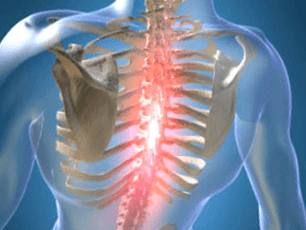
The disease occurs in the nucleus pulposus of the intervertebral disc, spreads to the fibrous fibrous ring and other parts of the vertebral segment, which ensure the mobility of the spine. The changes manifest themselves with neurological disorders and compression, reflex or mixed syndromes.
Pain occurs with physical exertion. There are several types of sensations:
- prolonged mild pain in the chest region is called back pain;
- acute and acute colic, which causes difficult inhalation or exhalation, which leads to immobility of the muscles - dorsago.
Symptoms and treatment of osteochondrosis of the thoracic spine depend on the degree of wear of the bone system and the stage of aging, which are generalized and local.
Symptoms include:
- damage to the peripheral processes of the nerves (neuralgia), characterized by painful attacks along the intercostal vasoconstrictors;
- concentration of pain in the left side of the chest or the appearance of a sharp painful sensation of a shingles nature;
- reduced mobility of the spine in the chest area;
- numbness in the arms and hands;
- impaired sexual function;
- the appearance of pain in the area of internal organs, can give to the heart, stomach, liver;
- low back pain in the neck, cheekbones and head, cough or lump in the throat;
- arrhythmia, tachycardia, fever.
Signs of osteochondrosis are masked by manifestations of related diseases, so the symptoms are ambiguous. The spinal nerves are concentrated around the spinal column; when blocked, the signals are sent to different parts of the body and organs.
Causes of osteochondrosis
There is no exact information on what factors deform the intervertebral discs. A common reason for osteochondrosis is scoliosis or curvature of the spine, which is most often recorded in childhood and adolescence.
The theory considers such vertebral deformity factors:
- disontogenic;
- hormonal;
- vascular;
- functional;
- involutional;
- infectious;
- immune;
- dysmetabolic;
- mechanical;
- hereditary.
Deterioration and aging of bones and cartilage occurs as a result of previous exposure to adverse conditions. Atrophic degenerations of the spine are predetermined by a genetic factor, and a disease with clinical symptoms manifests itself under the influence of an exogenous and endogenous environment.
The consequence in the form of complications in the work of the vertebrae occurs when the process of destruction of complex substances prevails over their synthesis. An exacerbation occurs when the disk's power supply is disturbed and there is a shortage of useful elements. The penetration of elements and dissimilation products decreases, cell viability decreases and parts of cells accumulate due to self-destruction. The production of complex proteins is reduced, collagen fibers are destroyed.
The mechanical effect on the formation of the annular connective increases, the layered structure is disorganized, the fibrous skeleton is torn. The disc is bruised under the influence of biomechanical factors and body movements, and its fixation capacity decreases. Blood vessels and nerves can grow in the ring due to a decrease in hydrostatic pressure.
Diagnostic methods
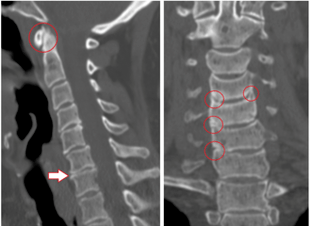
In the recognition process, root, pain, reflex, myotonic, autonomic and vascular factors are identified. The best method of examination is difficult to identify, because in each case the diagnosis is made individually.
The main methods are:
- X-ray diagnostics;
- CT scan;
- Magnetic resonance.
Radiography analyzes the condition of the spine, images are provided in oblique, lateral and direct projections. Sometimes, for a photo, a person bends over, stretches out, or bends over to the side.
Contrast radiography is divided into the following studies:
- pneumomyelography - 20 to 40 ml of air are injected into the spinal canal;
- angiography: 10 ml of contrast medium is injected into the vertebral lumen and 7 to 9 images are acquired in 2 - 3 seconds;
- myelography: an injection of a coloring liquid is carried out in the subarachnoid lumen, followed by a transillumination of the structure;
- discography: the stained substance is injected directly into the disc for localized examination.
Computed tomography evaluates the bone and tissue structure, the state of blood vessels. The painless method captures three-dimensional images in minutes.
Advantages of CT:
- high detection rate;
- screening of "mute" areas during on-the-go diagnostics;
- the possibility of multispiral angiography;
- recognition of long objects by obtaining high quality low thickness cuts.
MRI uses the magnetic field of a machine that builds hydrogen atoms in the human body in parallel with action. Particles signal, the response is recorded. The tomograph recognizes the waves and shows the result on the screen. With MRI, there is no radiation, the method is less dangerous, but it is not recommended for pregnant women.
Treatment and prevention
It is necessary to treat osteochondrosis in several stages, the complexity depends on the severity of the disease, contraindications and body resources.
methods:
- drugs and medicines;
- methods of physiotherapy, exercises to remove clamps, relieve the patient's condition;
- operation.
There is a direction of kinesitherapy, within which it is possible to cure spinal problems in the form of hernia, spondylosis with rehabilitative gymnastics. In addition, a recovery method after surgery has been developed.
Yoga exercises help adult men, women, a child to overcome pain, warning that the main thing is a psychological attitude.
Medicines
Drugs are prescribed by a neurosurgeon or neuropathologist in accordance with the card and anamnesis. Patients take drugs in the hospital or at home, the main thing is to follow the instructions and not deviate from the intake regimen.
Common Medicines:
- NSAIDs relieve pain, fever and inflammation;
- muscle relaxants lower the muscle tone of the skeletal skeleton;
- hormones reduce nerve pain;
- vitamins B2, B6, B12, A and C are taken during remission and for simple prophylaxis;
- diuretics relieve swelling and release pinched root nerves;
- neurometabolic stimulants improve metabolism in nerve tissues;
- chondroprotectors restore the cartilage of the vertebrae after damage.
Sometimes the patient does without drugs at the first stage of the onset of unpleasant sensations. Just exercise, use a massager.
Physiotherapy
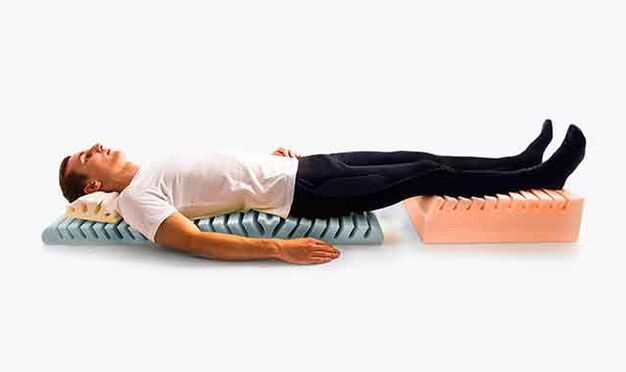
This type of exposure is used in conjunction with drug treatment or separately. Further, bed rest is applied, heat is applied to the affected area. Folk recipes are used for pain relief.
Physiotherapy in a medical institution includes procedures:
- ultrasound and phonophoresis;
- shock wave therapy;
- keeper impact;
- laser therapy;
- electrotherapy;
- magnetic waves;
- mud therapy and balneotherapy;
- massage.
Ultrasound involves the effect of high-frequency waves on tissues, which reduces pain sensitivity. With ultraphonophoresis, painkillers and anti-inflammatory drugs are added for their best administration to the affected areas.
Shock wave therapy is the transmission of an acoustic wave to the painful area, it is used to improve blood circulation, speed up metabolism. Detensor therapy consists of lengthening the spine using the patient's body weight.
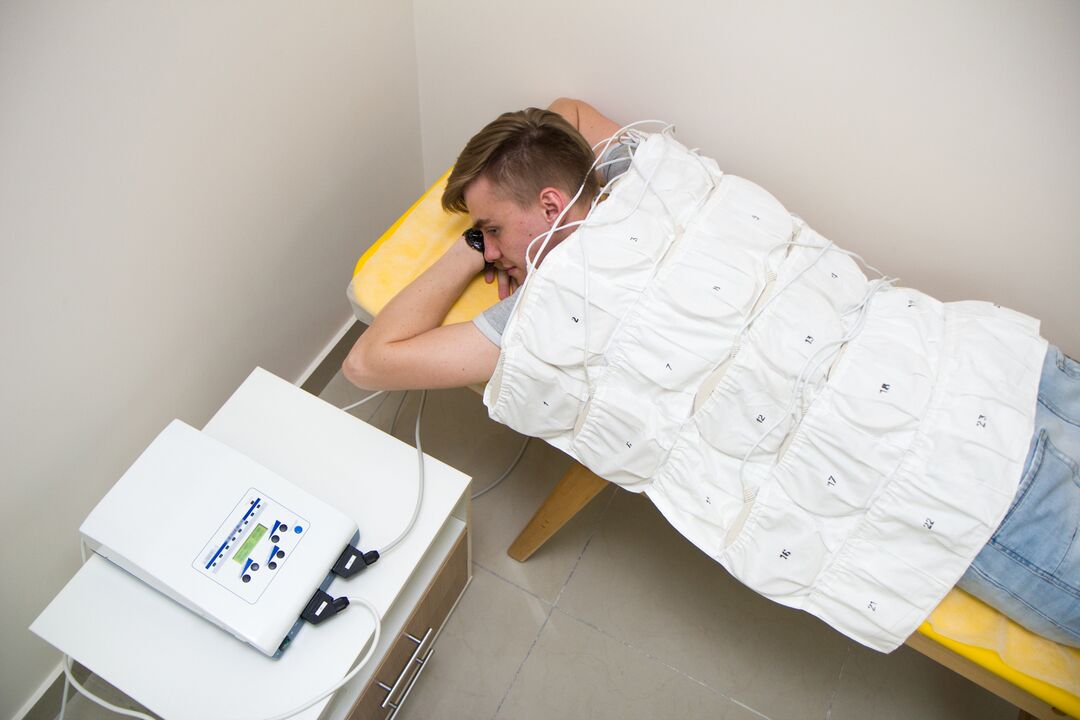
Laser therapy is based on the generation of helium-neon lasers to activate bioelectric currents in the nerve fibers. The laser acts on the inflamed nerve roots in the paravertebral region along the thoracic region.
Electrotherapy improves nutrition and metabolism of products in the tissues, and impulsive currents affect the sensory nerve endings. Low-frequency waves relieve acute pain and are used as first aid.
Magnetotherapy is used to relieve swelling, spasms and inflammation. A magnetic wave inductor is placed on the affected chest region. Balneotherapy and mud therapy consist of baths in the pool, baths, contrast showers for treatment and during recovery. Metabolism is normalized, blood flow to the affected areas is accelerated, pain and inflammation are reduced.
Therapeutic massage for osteochondrosis of the thoracic spine is hollow, punctiform and lymphatic drainage, improves blood microcirculation, tissue nutrition and tones the muscles. Sessions are conducted by a competent specialist, if you entrust the spine to amateurs, dangerous consequences can ensue. Massage is prescribed after the end of the acute phase, the first session should not exceed 10 minutes.
Operative treatment
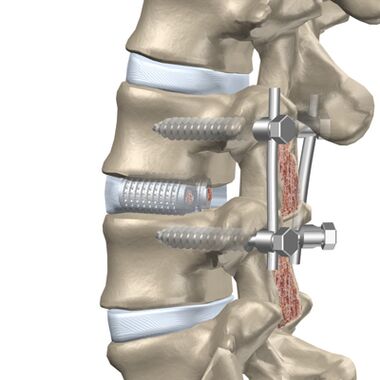
The patient is indicated for an operation if medical treatment, massage and other procedures do not alleviate the condition.
The intervention is divided into 2 phases:
- elimination of the cause of severe pain (decompensation);
- stabilization of the spine.
Using the posterior approach, a facetomy is performed, because the facet joints can press on the nerves. Foraminotomy is the expansion of the root canal through which the nerve leaves the vertebra. Laminectomy removes the posterior portion of the vertebra, which protects the spinal lumen and presses on the brain due to the deformity. Laminotomy involves widening the opening of the canal, where the spinal cord is located, by removing a separate fragment of the posterior region of the vertebra.
Anterior surgery is done if there is a protrusion (bulging of the vertebral disc towards the spinal lumen) or a hernia that protrudes towards the canal.
The following methods are used for frontal decompression:
- discectomy - removal of an entire disc or a separate part of it;
- corpectomy - removal of an entire vertebra and adjacent disc followed by implantation.
Discectomy and corpectomy lead to destabilization of the spine and increase the risk of neurological defects. Rigid fixation or fusion of three vertebrae (fusion) is used.
Prevention of thoracic osteochondrosis
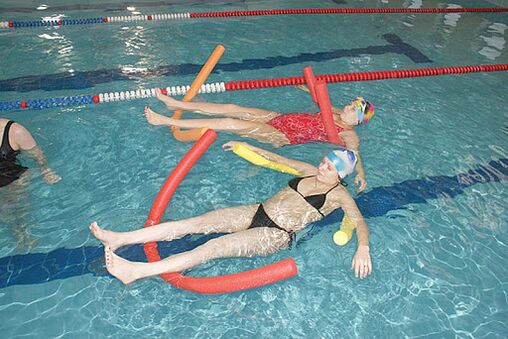
Exacerbations of the disease reduce the ability to work and the quality of human life, therefore, special attention is paid to prevention. As a result, spinal degeneration appears later and disability is avoided.
Methods to prevent the disease:
- decrease in physical activity on the spine;
- you can not sit still for a long time without changing the supporting limb, you can lean against an improvised object or a wall;
- it is not recommended to sit at a desk for a long time, and when working with a computer, it is necessary to take active breaks, walk;
- orthopedic mattresses and headrests are selected for sleeping;
- when running and walking, it is necessary to avoid sudden turns and jumps, walk in shock-absorbing shoes with small heels;
- carry weights not exceeding 10 kg, gradually lift from a sitting position.
In the car it is necessary to use padding for the backrest and head restraints, while the driver's seat must be rigid. Work can not be done in a semi-inclined position, you can stand or sit. Well-developed muscles support the skeleton, so pay attention to feasible physical education and hardening.
Possible complications
The disease develops for a long time, sometimes pain symptoms do not manifest themselves immediately. Any degenerative changes in the thoracic region lead to the appearance of pathologies.
Types of complications:
- pathology of the heart vessels with subsequent myocardial infarction or angina pectoris;
- intercostal neuralgia or inflammation of the peripheral nerves with chest pain from radicular compression;
- protrusion of the intervertebral discs.
Complications occur with advanced forms of osteochondrosis, so timely treatment in the early stages will help to avoid concomitant diseases.


























